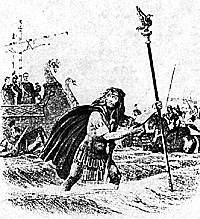 Published by Sarpedon, NY, 1996. Price $14.95 Softbound.
Published by Sarpedon, NY, 1996. Price $14.95 Softbound.
Attracted as much by the art on the cover as by the title, I picked up this book to give it a quick look but ended up buying it. Based upon contemporary texts, especially Caesar's own Gallic Wars, archaeological finds and a first hand tour of the various battlefields and topography mentioned by Caesar and later historians, Mr. Jimenez follows the Roman armies as they subjugated Gaul and sailed to Britain for two brief expeditions.
The battle accounts are well written, and there is an emphasis on strategic as well as tactical inovations by both sides. The author continually backs up his writing with recent archaeology (as a subscriber to Archaeology magazine, I try to keep upwith this aspect of historical exploration as well) and scholarship as well as with contemporary observations. For instance, I was not aware of the fact that Napoleon III had actually built a full size Roman trireme to sail down the Seine, or that he wrote a history of Julius Caesar, though not a ver y good one, the author points out. The Emperor also financed a massive archaeological undertaking to establish the identity of towns and battlefields mentioned by Caesar as being in Gaul circa 50 B.C.
The ferocity of the Roman army, as well as its potential brittle nature, serves to make Julius Caesar's numerous victories more a product of his brilliant generalship, rather than as a result of his simply being in command of a superb fighting machine, as some historians have tried to point out. In Caesar's own words, the author describes the frenzied nature of the Roman soldiers as they attacked Ariovistus' Germans: "Many of our men actually jumped onto the wall of shields, wrenched the shields from the enemy's hands and stabbed down at them from above." Hardly sounds like the archetypal well-trained and disciplined Romans most write about, article-wise and rules-wise alike.
Mr. Jimenez points out many intersting an unusual practices extent among the Celts. One fact that I found out was that, according to x-ray microanalysis of a body pulled from a peat bog in Lindow, England, done it 1991, the Britons actually used a clay-based pigment, heavy with iron and copper, to color their skin instead of the long accepted application of woad, to give themselves an "intense blue hue." This is just an example of the many enlightening and informative points the author makes in this superb book. Highly recommended.
More Reviews
-
Caesar Against the Gauls (book)
Battles of the Bible (book)
Museum Miniatures 15mm Early Byzantines (miniatures)
Back to Saga #63 Table of Contents
Back to Saga List of Issues
Back to MagWeb Magazine List
© Copyright 1998 by Terry Gore
This article appears in MagWeb (Magazine Web) on the Internet World Wide Web. Other military history articles and gaming articles are available at http://www.magweb.com